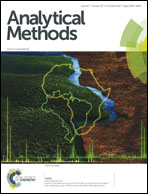Analysis of oxybutynin and N-desethyloxybutynin in human urine by dispersive liquid–liquid microextraction (DLLME) and capillary electrophoresis (CE)
Abstract
A dispersive liquid–liquid microextraction (DLLME) procedure combined with capillary electrophoresis/diode array detection (CE/DAD) was developed and applied to the determination of oxybutynin (OXY) and N-desethyloxybutynin (DEO) in human urine. The electrophoretic analyses were performed using a 50 μm i.d. fused silica uncoated capillary with an effective length of 36.5 cm and a 50 mmol L−1 solution of triethylamine, pH 3.0, as the background electrolyte. The temperature was set at 30 °C and a constant voltage of +30 kV was applied. Some experimental parameters that affect DLLME's extraction efficiency, such as the type and volume of the extraction and disperser solvents, extraction time and pH, were studied and optimized. The optimal DLLME conditions were found using the following method: 2.5% (w/v) NaCl was added to 5.0 mL of urine, the pH was adjusted to 11.0 and 140 μL of carbon tetrachloride as the extraction solvent and 260 μL of acetonitrile as the disperser solvent were quickly added. The performance criteria for linearity, sensitivity, precision, accuracy, recovery and stability have been assessed and they were within the Guidance for Industry: Bioanalytical Method Validation. The mean extraction recoveries for OXY and DEO were 71.4% (SD 6.4%) and 60.9% (SD 8.5%), respectively. The method showed linearity over the concentration range of 90–300 ng mL−1 and 187.5–750 ng mL−1, with correlation coefficients of 0.990 and 0.998 for OXY and DEO, respectively. Intra-day and inter-day precision and accuracy assays for these analytes were studied at three concentration levels and were lower than 15%.


 Please wait while we load your content...
Please wait while we load your content...